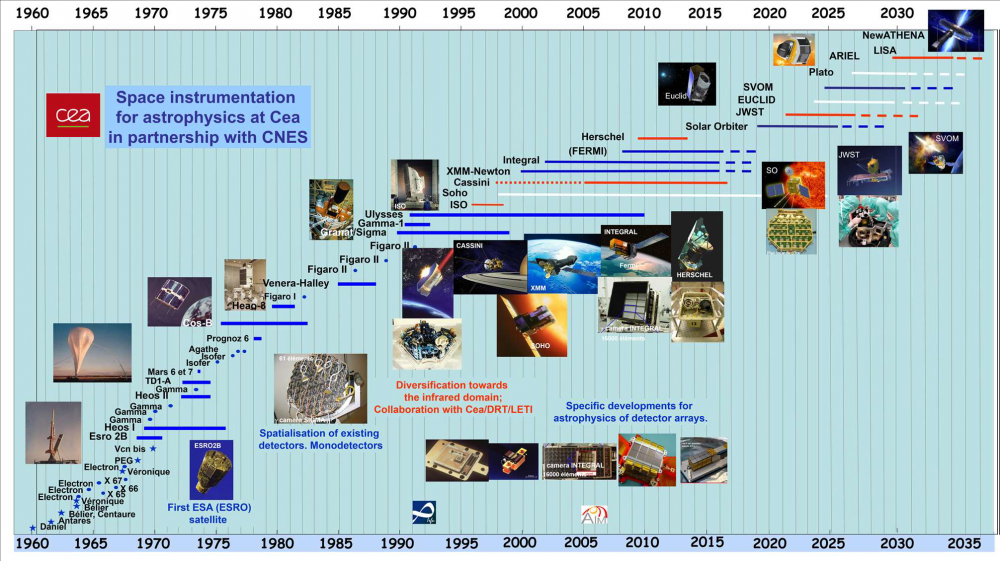A major space laboratory
The Astrophysics Department, UMR AIM within IRFU, is one of the major space laboratories in France, at the European and international levels. In direct collaboration with CNES, which oversees the space activities of French laboratories, it is heavily involved in the space missions of ESA's Cosmic Vision scientific program, as well as in bilateral missions led by CNES.
The development of astrophysics at CEA began in partnership with CNES from its inception in the early 1960s. Astrophysics is a rapidly growing science due to its high potential for discoveries. Increasingly numerous and powerful instruments, both ground-based and satellite-based, allow us to probe the universe with enhanced angular resolution and sensitivity across the entire electromagnetic spectrum. At the same time, modeling, particularly through numerical simulations, is becoming increasingly important in astrophysics; astrophysical problems are often complex and involve other disciplines of physics. Astrophysics and other fields of physics enrich each other mutually.
The Department of Astrophysics
The Department of Astrophysics (DAp) is one of the departments within the Institute of Research into the Fundamental Laws of the Universe (Irfu) under the Directorate of Fundamental Research (DRF) of the CEA. It is located at the Paris-Saclay site, at l’Orme des Merisiers, 20 km south of Paris, and near several universities and other research centers on the Saclay plateau.
The DAp primarily encompasses the Joint Research Unit (UMR) AIM (Astrophysics, Instrumentation, Modeling), under the joint supervision of CEA, CNRS, Université Paris-Cité, and Université Paris-Saclay. Research conducted at AIM is based on three pillars: space instrumentation (with upstream R&D), observations (using innovative data analysis techniques), and modeling (primarily based on multi-scale numerical simulations). These three activities mutually reinforce each other in a virtuous cycle, enabling a high visibility profile, making AIM a dynamic and highly active research environment that meets the highest international standards.
The UMR AIM comprises approximately 190 people, including 110 permanent and 80 non-permanent members (see Key Figures). The unit includes:
- Research engineers and technicians from DAp and DEDIP (Department of Electronics, Detectors, and Computing for Physics) of the CEA’s IRFU;
- Professors and associate professors from the Physics Department of Université Paris-Cité;
- Researchers and ITA from INSU (National Institute for Earth Sciences and Astronomy) of CNRS;
- Astronomers from CNAP (National Council of Astronomers and Physicists);
- Professors from Université Paris-Saclay;
- Support staff.
Structure of AIM
AIM has two main objectives:
- To develop research programs in astrophysics at the highest international level;
- To develop advanced instruments necessary for this research, along with the associated ground segments.
To achieve these objectives, AIM is composed of a management team, six teams organized around scientific themes to develop astrophysics research programs at the highest international level, and five teams organized by technical expertise for the development of cutting-edge instruments necessary for this research, as well as the associated ground segments.
Leadership Team
Given the objectives and the three supervisory institutions of AIM, the leadership team comprises:
- A director;
- A deputy director specifically responsible for astrophysics research;
- A technical director, who is also a deputy director for CEA;
- A deputy director responsible for aspects related to Université Paris-Cité;
- A deputy director responsible for aspects related to CNRS.
Astrophysics Research Team
In order to develop astrophysics research programs at the highest international level, the research division of the Astrophysics Department is organized into six teams:
-
Cosmology and Galaxy Evolution: The team focuses on studying the formation, evolution, and physical properties of large cosmological structures, galaxy clusters, the galaxies themselves, and up to the large scales of star formation.
-
Star Formation and Interstellar Medium: The team conducts a coherent and self-consistent study of the interstellar medium as a highly heterogeneous, dynamic, magnetized, and multi-phase fabric, across multiple wavelengths and at very different spatial scales.
-
Stellar Dynamics, Exoplanets, and Their Environment: The team develops cutting-edge research to understand the internal and external structure, dynamics, and evolution of the Sun, stars, and planets, as well as the atmospheres of exoplanets.
-
High-Energy Cosmic Phenomena: The team characterizes, classifies, and studies, from the perspective of fundamental physics, the most energetic and violent astrophysical phenomena.
-
Cosmology and Statistics: The team conducts research on the energy content of the Universe, primarily focused on the questions of dark matter, dark energy, and gravity.
-
Astrophysical Plasma Modeling: The team aims to understand astrophysical processes induced by gravity, radiative hydrodynamics, and MHD (magnetohydrodynamics), and to characterize their observable consequences.
Instrument Development Team
In order to develop the cutting-edge instruments necessary for this research, as well as the associated ground segments, the instrumental division is organized into five teams based on the following areas of expertise:
- Space Systems and Architectures: The team is responsible for defining the system architecture and maintaining technical oversight throughout the design, production, and testing of the various instrument models.
- Space Spectro-Imagers: The team conducts R&D on detectors ranging from the far-infrared to gamma-ray wavelengths, including bolometers, micro-calorimeters, and semiconductors.
- Design and Development of Space Electronic Systems: The team is responsible for defining, designing, and developing onboard electronic equipment.
- Quality Assurance and Space Integration: The team supports space projects in terms of Product Assurance and Quality Assurance for AIT (Assembly, Integration, and Testing) activities throughout the development and implementation phases.
- Science and Space Instrument Interface: The team operates at the interface between science and space instruments, from the design phases to the operational phase in flight.
History
Astrophysics at the CEA began in the 1960s with pioneering high-energy sky observation work using detectors installed in rockets (see Figure 1). A crucial diversification towards the study of the cosmos with infrared radiation was undertaken in the 1980s under the visionary direction of C. Cesarsky.
Another significant milestone for the laboratory was its integration into the Institute of Research into the Fundamental Laws of the Universe (IRFU) in 1992, becoming one of the seven departments of IRFU. This integration provided AIM with the opportunity to develop instrumental projects with the technical departments of IRFU, mainly the Department of Systems Engineering and the Department of Electronics, Detectors, and Computing, and to develop scientific projects with the Department of Particle Physics and the Department of Nuclear Physics.
The UMR AIM was established on January 1, 2005, to strengthen the long-standing collaboration between researchers from the Department of Astrophysics (DAp) of CEA/IRFU, CNRS/INSU researchers, present since 1979 as an associated research unit, and professors and associate professors from Université Paris-Cité, present since 1997 as a research team named "γ-gravitation."
In 2020, the UMR AIM joined the Paris-Saclay Observatory of Sciences of the Universe (OSUPS).







